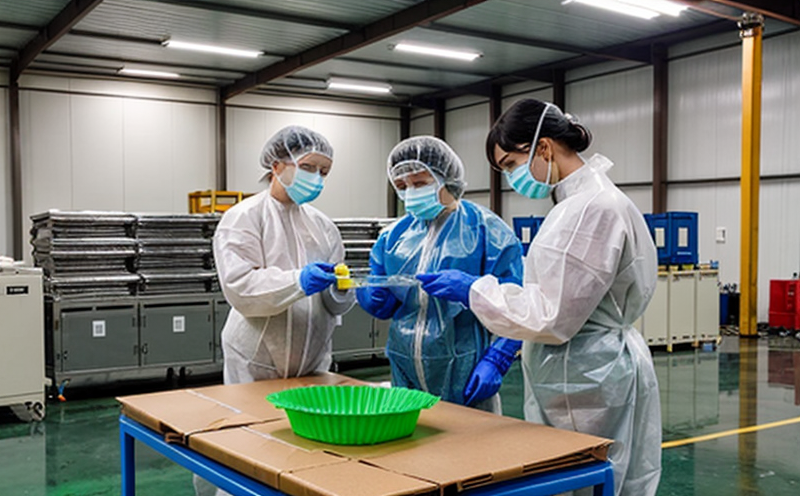ASTM F1249 Water Vapor Transmission Rate (WVTR) Testing
The ASTM F1249 standard is widely used to measure the water vapor transmission rate of plastic packaging films and sheets. This test is crucial for ensuring that the materials used in food, pharmaceutical, and household product packaging can prevent moisture from entering or escaping.
Water vapor transmission testing helps manufacturers ensure their products meet regulatory standards and consumer expectations regarding freshness and safety. By accurately measuring how much water vapor passes through a material over time, ASTM F1249 provides insights into the performance of plastic films under various environmental conditions.
The test involves placing a known weight of a specimen between two chambers: one with controlled humidity and temperature while the other is at standard atmospheric conditions. Over a specified period (usually 7 days), the weight change in the sample indicates the amount of water vapor that has passed through it. This data allows for precise calculation of the WVTR value.
Understanding the WVTR characteristics of plastic packaging is essential because it affects several key properties:
- Product Quality: Preventing moisture ingress preserves food and pharmaceutical products' quality and shelf life.
- Consumer Safety: Ensures that packaged goods remain safe for consumption without compromising on hygiene standards.
- Environmental Impact: Helps in designing eco-friendly packaging solutions by optimizing barrier properties while minimizing material usage.
- Cost Efficiency: Allows companies to balance cost-effectiveness with necessary functional requirements, reducing waste and improving resource utilization.
The ASTM F1249 test method is recognized globally for its reliability and accuracy. It helps businesses across various industries comply with industry-specific regulations and customer expectations regarding packaging integrity.
For instance, in the food industry, accurate WVTR testing ensures that perishable items like fruits, vegetables, or dairy products maintain their freshness during storage and transportation. In pharmaceuticals, it guarantees that medications remain stable within their intended shelf life without compromising efficacy due to moisture exposure.
Scope and Methodology
| Test Specimen | Description |
|---|---|
| Type | Plastic films, sheets, or coatings used in packaging |
| Thickness Range | 0.25 to 10 mm (adjustable based on material type) |
| Temperature and Humidity Control | Chambers maintained at specific conditions for accurate measurement |
| Measurement Parameters | Description |
|---|---|
| Initial Weight | Determined before placing the specimen in controlled environments |
| Final Weight | Measured after exposure to controlled humidity and temperature for a set duration |
| Water Vapor Transmission Rate (WVTR) | Calculated from weight change data, expressed as g/m²/day or mg/in²/24 hours |
The test setup involves placing the specimen between two chambers—one maintained at a higher humidity level and temperature than the other. The difference in relative humidity (RH) between these chambers is typically set to 60% RH, while maintaining a constant temperature of approximately 23°C.
After sealing the sample, it undergoes exposure for up to 7 days under these conditions. During this time, any water vapor that passes through the specimen will accumulate in the chamber with lower humidity. At the end of the test period, the final weight is measured and compared against the initial weight to determine the WVTR.
The calculation of WVTR involves several steps:
- Calculate the weight gain or loss during exposure.
- Determine the area of the specimen being tested.
- Apply the formula for WVTR based on the International System of Units (SI).
This method ensures consistency and accuracy, making ASTM F1249 an indispensable tool in quality assurance programs. Compliance with this standard not only enhances brand reputation but also contributes to sustainable practices by promoting efficient use of resources.
Customer Impact and Satisfaction
- Enhanced Customer Trust: Accurate WVTR testing builds confidence among consumers regarding product safety and quality.
- Better Product Performance: Optimizing packaging through precise WVTR measurements leads to extended shelf life and improved consumer satisfaction.
- Competitive Advantage: Meeting or exceeding industry standards can set a company apart in terms of innovation and reliability.
- Regulatory Compliance: Ensuring adherence to relevant regulations reduces the risk of legal issues and enhances corporate reputation.
- Cost Savings: Efficient packaging design minimizes material waste, reducing overall production costs without sacrificing functional requirements.
By leveraging ASTM F1249 testing, companies can ensure that their products meet rigorous quality standards, thereby fostering long-term relationships with customers and stakeholders alike. This approach also supports sustainable business practices by promoting resource efficiency.
International Acceptance and Recognition
The ASTM F1249 standard is widely accepted across numerous industries due to its robust methodology and consistent results. Many global organizations, including the European Union (EU), United States Food and Drug Administration (FDA), and international packaging associations, recognize this test as a benchmark for evaluating plastic packaging materials.
Compliance with ASTM F1249 demonstrates a company's commitment to maintaining high standards of quality assurance. This recognition enhances brand credibility and facilitates smoother interactions with regulatory bodies worldwide.





